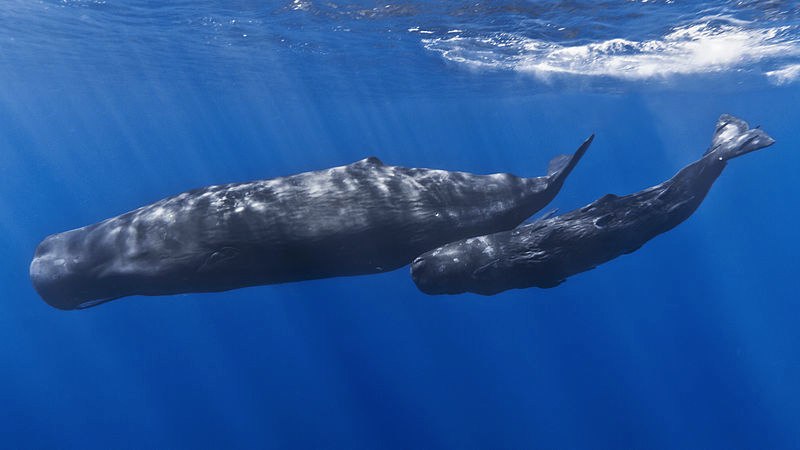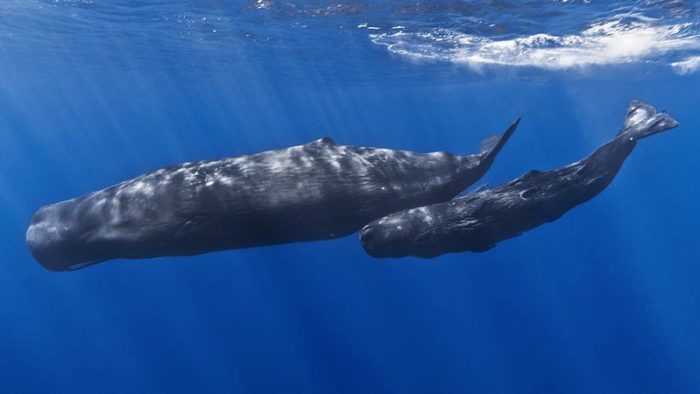
Sea Wonder: Dwarf sperm whale

Photo source: https://flic.kr/p/e1oaRA
There are sperm whales, pygmy sperm whales, and dwarf sperm whales that call the ocean home. Do you know the differences and what they have in common? Learn all about the dwarf sperm whale with this week’s Sea Wonder!
Appearance
Dwarf sperm whales are on the smaller end of the cetacean (toothed whale) spectrum, weighing between 300 and 600 pounds and reaching nearly nine feet in length when fully grown. They have compact bodies, a small dorsal fin atop their backs, and flat heads, which are sometimes compared to shark heads because their rostrums (snouts) are pointed and their lower jaws narrow. Behind their dark eyes, dwarf sperm whales have a false gill, named for its resemblance to a fish’s gill cover. Inside their mouths are cone-shaped teeth used for catching and swallowing prey whole.
Like nearly all other whales, dolphins, and porpoises, dwarf sperm whales have darker colored backs and lighter bellies, which is a form of camouflage used in the marine environment to help with hunting and survival — this is because when looking down, the animal’s darker back blends in with the ocean’s depths, and when looking up, the lighter belly blends in with the light coming from the water’s surface.
Dwarf sperm whales look similar to their cousins, the pygmy sperm whale, and are often mistaken for one another. However, pygmy sperm whales are larger, have a larger habitat range, feed in deeper waters, and have different social structures than dwarf sperm whales.
Diet & Habitat
Dwarf sperm whales feed on cephalopods like squid and octopus, crustaceans like crabs and shrimp, and many species of fish. They are known as opportunistic feeders, though, and will feed on whatever is easiest to find and catch. Dwarf sperm whales can dive at least 1,000 feet when pursuing prey, and possibly even deeper.
Dwarf sperm whales call temperate and tropical waters around the world home, including waters near Hawai’i, the Pacific Northwest and California, and the northern portion of the Gulf of Mexico. They are the sixth most common toothed whale seen in the Hawaiian Islands, and can likely be seen in Hawaiian Islands Humpback Whale, Florida Keys, Monterey Bay, Cordell Bank, Channel Islands, Greater Farallones, Gray’s Reef, Monitor, Flower Garden Banks, and Stellwagen Bank national marine sanctuaries.
Globally, dwarf sperm whales can also be found near Australia, Japan, Chile, Indonesia, Brazil, South Africa, Mexico, and the Maldives. Despite their wide distribution, dwarf sperm whales are elusive and not easily observed by scientists, so we don’t know much about their migration patterns or how populations are distributed.
Life History
Dwarf sperm whales live individually or in small groups of no more than 16 individuals. Scientists know little else about their social groups and behaviors.
Females give birth to one calf after a gestation period of about a year, usually giving birth during the summer months. Calves are about three feet long and 30 pounds at birth, and will nurse from their mothers for about a year after birth. They reach sexual maturity between three and five years old and have an estimated lifespan of around 23 years old.
Dwarf sperm whales are unique among toothed whales in that they can expel dark liquid from a sac near their intestines when they feel threatened or are trying to escape predators. This is known as the “squid tactic” due to its similarities to defense mechanisms used by squid and octopus.
Threats & Conservation
We don’t know much about the population health of dwarf sperm whales, but they are protected in the United States under the Marine Mammal Protection Act of 1972. Like all other species of whales and dolphins around the world, we know marine debris, entanglement, overfishing, vessel strikes, ocean noise, and overfishing are threats to this species. We can all do our part to protect dwarf sperm whales, the animals on which they rely for food, and their habitats by reducing our use of single use plastics and other items, cleaning up our fishing gear, and encouraging our elected officials to enact policies that are beneficial to marine mammal species.
Want to know more about dwarf sperm whales? Visit the species directory by NOAA’s National Marine Fisheries Service.
